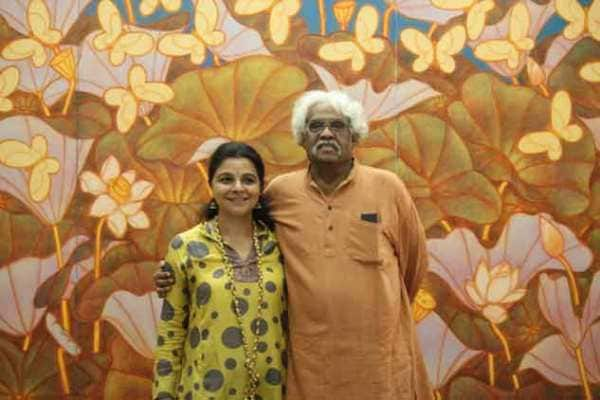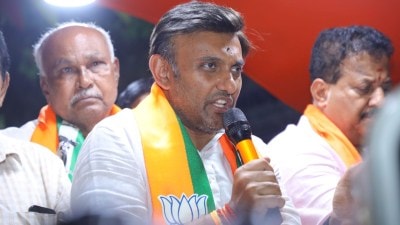- India
- International
Artist Ramachandran sees nature as intrinsic to human existence
A Ramachandran, 80, is known primarily for his massive mural-like oil paintings.
 Standing tall A Ramachandran with student Manisha Gera Baswani; the artist with his sculpture, Monumental Gandhi.
Standing tall A Ramachandran with student Manisha Gera Baswani; the artist with his sculpture, Monumental Gandhi.
Manisha Gera Baswani
One of the leading figures in the contemporary Indian art scene, A Ramachandran, 80, is known primarily for his massive mural-like oil paintings. His rich body of work — spanning five decades — includes sculptures, water colours, ink and colour drawings, miniature paintings, illustrations for children’s books, stamps, ceramics and writings. Ramachandran’s solo show “Eklinji Fantasy”, which will open at Lalit Kala Akademi, New Delhi, on November 12, will have almost 1,500 drawings spanning his entire artistic career, and his recent oil paintings and sculptures. In conversation with his former student, artist and photographer Manisha Gera Baswani, Ramachandran talks about his childhood in Kerala and his journey to being an artist.
Manisha Gera Baswani: Born in a small principality, Attingal, in Kerala, you grew up with an intimacy with nature, urban people like us have only read about in Alice in Wonderland or visualised through the eyes of Roald Dahl during our growing years. Tell us about your childhood in Kerala and, subsequently, your studies at Santiniketan.
A Ramachandran: I would skip across paddy fields, find my way to local temples, absorbing my surroundings, partaking in the daily rituals of a culturally rich town and, at the same time, imagining my own personal canvas. This left a mark on my fertile young mind.
“Go out to nature and sketch,” was the first instruction I got from my teacher, Ramkinkar Baij, at Santiniketan. Probably, he got the same advice from his teacher, Nandalal Bose, years ago. He had faithfully followed the path to which his teacher had led him and I, too, have been doing the same.

This is probably the first time that art lovers will get a chance to see the rich repertoire of your drawings, spanning 50 years of your artistic journey.
The drawings in the show are an autobiographical journey. They are a window to my artistic preoccupations, my ideology, family and friends, and my love for the Bhils of Rajasthan.
Drawing is an integral part of my daily ritual. It keeps me in touch with my profession every day. It helps me record sensations that are evoked when I see something inspiring. Just like a musician needs to string the tanpura everyday to do his riyaaz, I need to draw.
Is the title of the show, ‘Eklinji Fantasy’, a tribute to Bhils?
Eklinji is the epicentre of all my interests. This magnificent oasis in Rajasthan, unchanged still, is my muse. Evoking the air of the classical bordering on the folk, Eklinji can be compared to a miniature painting for its abundance of lotus ponds, flora, fauna, seasons, rituals and its graceful inhabitants, the Bhils. It is a place where man still lives in harmony with nature. Capturing its essence and recording their life and rituals on my regular sketching trips to this land help me arrive at my painting.
Exhibited in this show is a sculpture of Gandhiji, titled Monumental Gandhi. You have drawn him, designed Indian postage stamps bearing him and even done a mural on him at Gandhi Darshan, New Delhi. What makes you come back to him time and again?
Gandhiji has been my greatest inspiration. As a child, I was enamoured by him. One of my favourite teachers was a Gandhian. He wore only khadi. Once, when he invited me to his house, I made my parents buy me a khadi shirt and long shorts to wear to his house. In fact, when Gandhiji died, I was very young, but I remember crying all day. The next day, I cut his photograph from the newspaper and put it in my puja room, so deep was my respect and love for him.
As a child, when you get inspired by a great person, it stays etched in your mind even when you grow old. He epitomises the principle of morality. I have endeavoured to live by it in my personal as well as professional relationships. The stark simplicity of his life and philosophy is probably what draws me to the Bhils for their harmonious coexistence with nature.
For me, this sculpture is symbolic. While I have kept the surface of his visible body rough and expressionistic, I have garbed him in a glowing, reflective metallic robe.
How do you see your art now? Has there been any shift?
I shared many common features and elements with my contemporaries before the “Yayati” series (1986). But I broke away from the mainstream art movement and evolved a personal connection with nature. I see nature as intrinsic to human existence. In a sense, I was revisiting the philosophy of Nandalal Bose. My intimate contact with tribals and their life was not only to represent them as they were, but to take them to the realm of magic realism.
What are your views on contemporary art?
I don’t know much about contemporary art to make a qualified statement. Being an artist of an earlier generation, I prefer not to sit in judgement on younger artists. They belong to a world influenced by technology and global culture which I neither know nor live by. But I am aware that there are many intelligent and active artists from Kerala who are far ahead of artists from other states. Their educational background and political awareness gives them a sound base in formulating personal expressions.
What does Kerala mean to you?
At this age, I don’t feel at home even in my own house. These thoughts are relevant when one is young. My emotional association with Kerala ended when I finished my book on the Kerala murals. To publish my research of 40 years was an obligation I owed to my land of birth. The Kerala murals are part of my cultural inheritance. I felt they needed to be preserved and recorded.
At my age, going to Kerala has as much complexity involved as going to any other metropolitan city. Therefore, I prefer to visit a place like Udaipur, where life is still not that complex even though basic amenities are less. I feel I am at a winding up stage. I do not have too many attachments any more.
Apr 27: Latest News
- 01
- 02
- 03
- 04
- 05




































